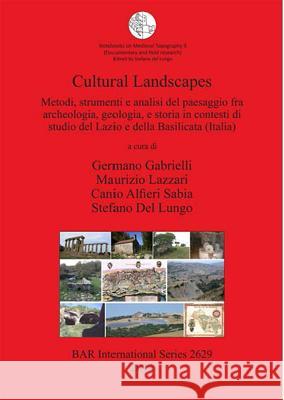Cultural Landscapes: Metodi, strumenti e analisi del paesaggio fra archeologia, geologia, e storia in contesti di studio del Lazio e della » książka
Cultural Landscapes: Metodi, strumenti e analisi del paesaggio fra archeologia, geologia, e storia in contesti di studio del Lazio e della
ISBN-13: 9781407312668 / Włoski / Miękka / 2014 / 432 str.
Cultural Landscapes: Metodi, strumenti e analisi del paesaggio fra archeologia, geologia, e storia in contesti di studio del Lazio e della
ISBN-13: 9781407312668 / Włoski / Miękka / 2014 / 432 str.
(netto: 540,54 VAT: 5%)
Najniższa cena z 30 dni: 550,14 zł
ok. 30 dni roboczych.
Darmowa dostawa!
The ninth volume of Notebooks on Medieval Topography (Documentary and field research), gives much input into research about Cultural Landscape. Latium (Monte Romano; Viterbo), and Basilicata (provinces of Potenza and Matera) are the Italian lands chosen to which methods, instruments and analyses, have been applied. Research from geology, archaeology, history, agronomy, history of art, engineering, architecture, literature, photography and cinema have all been used to contribute to a better analysis of Cultural Landcsape, i.e. the Space affected by Time and Human action. The whole area of Basilicata has been studied, especially the northern, central and eastern side (artistic and architectural heritage). In Latium the primary area of interest has been the village of Monte Romano and its county. The landscape evolution has been examined from the Roman period (III cent. B. C.) until the contemporary one. The last part discusses thoroughly the economic condition of the lands along the river Marta, between Tuscania and Corneto (Tarquinia) in XV and XVI cent. During this period there was organized cattle breeding and an ancient bovine race (the Maremmana). Combining survey, bibliographic and archival recovery of unpublished documents, without neglecting any aspect (such as the cataloguing of springs), the Cultural Landscape has been examined from different perspectives, even those that seem less relevant (cattle-breeding, agricultural and food), but are still an economic resource. Thus they are very important to a cultural development. The research, exploring a fairly wide range of possibilities, wants to be a stimulus to those who want to study a complex and articulate reality like Cultural Landscape.
The ninth volume of Notebooks on Medieval Topography (Documentary and field research), gives much input into research about Cultural Landscape. Latium (Monte Romano; Viterbo), and Basilicata (provinces of Potenza and Matera) are the Italian lands chosen to which methods, instruments and analyses, have been applied. Research from geology, archaeology, history, agronomy, history of art, engineering, architecture, literature, photography and cinema have all been used to contribute to a better analysis of Cultural Landcsape, i.e. the Space affected by Time and Human action. The whole area of Basilicata has been studied, especially the northern, central and eastern side (artistic and architectural heritage). In Latium the primary area of interest has been the village of Monte Romano and its county. The landscape evolution has been examined from the Roman period (III cent. B. C.) until the contemporary one. The last part discusses thoroughly the economic condition of the lands along the river Marta, between Tuscania and Corneto (Tarquinia) in XV and XVI cent. During this period there was organized cattle breeding and an ancient bovine race (the Maremmana). Combining survey, bibliographic and archival recovery of unpublished documents, without neglecting any aspect (such as the cataloguing of springs), the Cultural Landscape has been examined from different perspectives, even those that seem less relevant (cattle-breeding, agricultural and food), but are still an economic resource. Thus they are very important to a cultural development. The research, exploring a fairly wide range of possibilities, wants to be a stimulus to those who want to study a complex and articulate reality like Cultural Landscape.











